Heath Town
Heath Town is a district of Wolverhampton, West Midlands, England, located east of the city centre. It is also a ward of City of Wolverhampton Council. The ward forms part of the Wolverhampton North East constituency.
| Heath Town | |
|---|---|
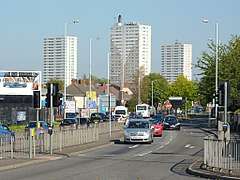 Wednesfield Road and Heath Town tower blocks | |
 Heath Town Location within the West Midlands | |
| Population | 13,965 (2011 Census.Ward)[1] |
| OS grid reference | SO9266199324 |
| Metropolitan borough | |
| Metropolitan county | |
| Region | |
| Country | England |
| Sovereign state | United Kingdom |
| Post town | Wolverhampton |
| Postcode district | WV |
| Dialling code | 01902 |
| Police | West Midlands |
| Fire | West Midlands |
| Ambulance | West Midlands |
| UK Parliament |
|

Heath Town ward borders the wards of Bushbury South and Low Hill, Fallings Park, Wednesfield North, Wednesfield South, East Park and St Peter's.
As well as Heath Town, the ward covers parts of Park Village, Springfield, Horseley Fields and Wednesfield. It is home to New Cross Hospital (the city's main Hospital), Wolverhampton Railway station, Heath Park Secondary school and a Royal Mail distribution centre.
History
The railways reached Wolverhampton in 1837, with the first station located at Wednesfield Heath, later known as Heath Town, on the Grand Junction Railway. This station was demolished in 1965.[2]
In 1850 the Holy Trinity Church and almshouses were built, as part of the expansion of Heath Town and in 1888 the separate Wednesfield and Heath Town urban district councils were created.[3] The Heath Town Urban District was later abolished in 1927 to become part of Wolverhampton.)[4]
In the late 19th century, many terraced houses were built next to the factories near the main road to Lichfield. In the 1960s many of these were demolished, they were replaced with a new estate designed by Wolverhampton Borough architects. The new Heath Town estate was officially opened in April 1969 by Princess Margaret. The former street plan was defined by the line of the Wolverhampton Road and Lincoln, Inkerman and Grove streets have kept their original names.[5]
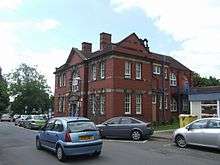
New Cross Hospital is built on the site of the former New Cross Workhouse. The design of the new buildings came about through a competition and the winning entry was from Arthur Marshall of Nottingham. The foundation stone was laid in September 1900 by Chairman of the Guardians, Mr Price, and the workhouse was formally opened on 24 September 1903. The workhouse could take up to 1,246 inmates, 20 nurses, and 60 other officers. The buildings occupied an area of six acres, and the total cost was £156,879. After 1930, control of the workhouse site passed to the Wolverhampton Public Assistance Committee and it became New Cross Hospital. Many of the old workhouse blocks have now been replaced by modern buildings.[6]
In the 1900s the Chubb Lock and Safe Company was a major employer in Heath Town. In 1908 the Chubb safe works was opened on Wednesfield Road and workers were transferred from the London safe works which had closed.[7] In 1938 Chubb & Son's Lock & Safe Co Ltd premises were expanded and workers were moved from the premises in Railway Street.[8][9] Chubb remained an important industry in Heath Town until 2000 when it was sold to Assa Abloy, a Swedish lock maker and Gunnebo, another Swedish security company. The Wednesfield Road safe works were closed and much of the site was sold off for housing.[7]
Demographics
White British residents are still the largest ethnic group in Heath Town. However, it has a large percentage of Asian and Afro-Caribbean residents who migrated to England during the 1950s and 1960s and originally settled in the Victorian terraces before relocating to the modern council flats. In more recent years, the area has become a popular destination for Eastern European and African immigrants.
The 2011 census states the population as 13,965 made up of approximately 48% females and 52% males with an average age of 34. 70.0% of people living in Heath Town were born in England. 5.0% India, 3.1% Jamaica, 1.7% Zimbabwe, 1.6% Philippines, 0.9% Somalia, 0.7% Nigeria, 0.6% Ireland, 0.5% China, 0.5% Pakistan.[10]
The 2011 census shows the ethnic mix of Heath Town ward as predominantly white:
- 48.66% white British
- 16.4% black
- 16.1% Asian
- 8% mixed
- 7% white other
- 0.8% Chinese.[11]
80.7% of people living in Heath Town ward speak English. The other top languages spoken are 3.5% Punjabi, 2.1% Polish, 1.9% Kurdish, 1.2% Lithuanian, 1.0% Tagalog/Filipino, 0.7% Persian, 0.7% Somali, 0.7% Arabic, 0.6% Greek.[10]
The rich diversity of culture in the area is celebrated each August with an international fun day event on Heath Town Park.[12]
Religion
The religious make up of Heath Town is 52.9% Christian, 21.2% no religion, 7.4% Muslim, 6.4% Sikh, 2.8% Hindu, 0.5% Buddhist, 0.1% agnostic.[10]
Churches and temples in the area are:
Places of interest
Heath Town Park
Heath Town Park is a neighbourhood park that serves the local community. The site is a public memorial to the men of Heath Town who gave their lives in the Great War. The park is surrounded on three sides by residential properties with a main road running along the fourth. The main entrance to the park is from Church Street which is accessed from the residential area. The park is compact but has many facilities including two football pitches, play area, fitness trail, multi-use games area, wooded area, open space and seating. There is also a WW1 War Memorial said to be the oldest in Wolverhampton. The park is well used by the local community and since 2012 has been protected by Fields in Trust[18] as part of the Queen Elizabeth II Fields Challenge. This was a project to safeguard the future of parks and green spaces as public recreation land for future generations to enjoy and provide a permanent legacy of the Diamond Jubilee and the Olympics.[19]
Heath Town Baths
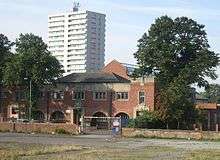
Heath Town public baths were designed by H. B. Robinson, Borough Surveyor and Engineer. They were opened on 16 December 1932, by Alderman F. A. Willcock, chair of Wolverhampton Borough Council's Parks and Baths Committee. The Main Swimming Bath was 75 feet long by 34 feet wide. The Children's Swimming Bath was 40 feet long by 25 feet wide-ranging from a depth from three feet to three feet three inches deep. The building also included Wolverhampton's first large public washhouse which housed four rotary washing machines, twenty one drying horses, three electrically operated hydro-extractors, fifteen washing stalls for hand washing, drying houses and irons. The building also housed Heath Town's public library. The baths eventually closed in 2002, and the library closed on 3 November 2006.[20]
Heath Town Baths is a grade II listed building and has both architectural and social-historical importance locally and architectural significance nationally. Since 2006 it has since fallen into substantial disrepair. The building sits at the heart of Heath Town and its preservation and bringing back into use is stated to be a high priority in the Neighbourhood Plan. The Tessa Sanderson Foundation and Academy supports the campaign to bring the baths back into use.[21] Heath Town Swimming Club which won several international competitions in the 1940s-1950s was based at the baths.[22]
Grand Station / Wolverhampton Low Level Railway Station
Grand Station is a Grade II listed building used as a venue for Weddings, Banquets & Conferences.[23] but was originally the Wolverhampton Low Level Station. The station opened 1854 and closed in 1981 but the buildings were listed in 1986.[24] [25]
Almshouses
A terrace of six, grade II listed, 19th century almshouses is located in the graveyard of Holy Trinity Church. They were built in 1850 by the benevolent industrialist Henry Rogers. After a period of dereliction, the houses were restored in 1996 to one bedroom houses for elderly people.[26]
Victoria Hall
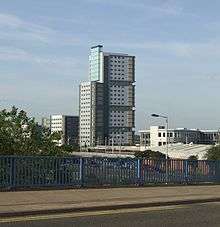
Victoria Hall is a block of student accommodation with four tower blocks in the Springfield area of Heath Town. The tallest block is 25 stories and is the tallest modular building in Europe.[27]
Housing
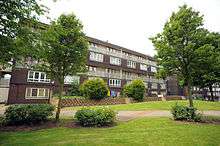
The area is mainly residential fronting on Wednesfield Road and in the centre of the estate itself. One of the last estates of tower blocks to be built in the area, it incorporated a number of features – a district heating scheme and deck level access. The estate's tower blocks were for a long time the city’s tallest residential structures and are visible landmarks from some distance. The blocks of flats are divided by grassed areas, the largest of which is in the south-central part of the development and designed for recreational use. The estate includes a variety of other housing types—including two-storey houses and low-rise maisonettes. Green space has been incorporated into the areas between blocks of flats and mature trees are visible along the southern edge of the estate.[5]
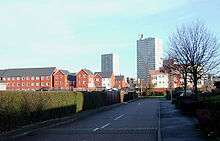
There is an extensive housing development off the Wednesfield Road on the former site of the Chubb Works which was part of the new century's Wolverhampton regeneration plan.[28]
The 2011 census shows housing types as:
- 47% purpose built flats
- 24% semi-detached houses
- 22% terraced houses
- 6% detached
- 1% converted or shared house
- 1% flats/apartments in commercial buildings.[11]
Education
Primary Schools in Heath Town are:
- Stephen's Church of England Primary School[29]
- Woden Primary School [30]
- Trinity Church of England Primary School[31]
The Secondary school is the highly rated Heath Park.[32]
Sport
Heath Town Swimming Club was originally based at Heath Town Baths [22] but now meets at the nearby Wolverhampton Swimming and Fitness Centre.[33]
Heath Town is home to Heath Town United Football Club.[34]
Transport
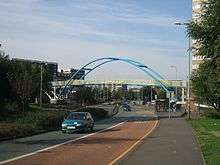
Roads
Heath Town straddles the A4124 Wolverhampton-Wednesfield Road, which runs westwards to Wolverhampton and eastwards to Bloxwich and eventually Brownhills It is bounded by railway lines to the north-east and south (the latter disused). Wolverhampton Railway Station is located in Heath Town.[5]
Railway
Wolverhampton station originally opened on 1 July 1852 by the Birmingham, Wolverhampton and Stour Valley Railway, a subsidiary of the London and North Western Railway (LNWR); it was named Wolverhampton Queen Street.[35] It was known as Wolverhampton High Level from 1 June 1885.[35] From 1923, it was operated by the London Midland and Scottish Railway (LMS), and in 1948 the station became part of the London Midland Region of British Railways.[36] The present Wolverhampton station dates from 1965, when the High Level station was completely rebuilt as part of the modernisation programme which saw the West Coast Main Line electrified.
The former Heath Town railway station, on the line from High Level to Wednesfield station, was just off Grove Street. Built by the Wolverhampton and Walsall Railway in 1872, and was operated by the Midland Railway from 1876, it closed in 1910.[2]
Wolverhampton Low Level Station was opened 1854 by the Oxford, Worcester and Wolverhampton Railway later to fall under the auspices of the Great Western Railway. It was closed to passengers in 1972, but continued to function as a parcels depot until 1981. Once an important stop on the London-Birkenhead line and linked with Snow Hill station in Birmingham. However, the station buildings were listed in 1986.[24] The building has since been redeveloped as a venue for weddings, banquets & conferences.[23]
Buses
Public transport is coordinated by Network West Midlands. Services run from the town centre to Heath Town and on to New Cross, Bentley Bridge and then to Cannock or Walsall.[37]
Canal
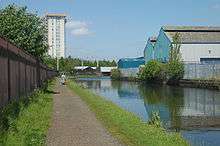
The Wyrley and Essington Canal passes through Heath Town. The canal runs from Wolverhampton via Wednesfield towards the coalfields at Essington and Great Wyrley, Bloxwich, Pelsall and Chasewater.[38]
Future Plans
Heath Town Master Plan
In 2013 the Heath Town Master Plan was unveiled setting out plans to increase the provision of housing by up to 550, improve community facilities and enhance landscaping.[39]
Heath Town Neighbourhood Plan
Heathfield Park Neighbourhood Plan[40] received a resounding yes vote on 17 July 2014 and will be taken to Wolverhampton City Council in September 2014 for adoption. The Plan will help to shape all future planning applications for the Springfield, New Park Village, Heath Town and New Cross areas of Heath Town. The Plan identifies six key themes for improving and sustaining the area which focus on identity and image, housing and environment, employment and skills, assets and buildings, transport and traffic and healthy living. [41] [42]
This is one of Wolverhampton's first neighbourhood plans (with Tettenhall) and puts Wolverhampton at the forefront of neighbourhood planning nationally. Wolverhampton is the first metropolitan area to hold a neighbourhood plan referendum and the first anywhere to hold a referendum with more than one area taking part. The plan was created by residents from Heathfield Park via their local neighbourhood partnerships, with support from the council's planning, housing and neighbourhood services teams.[43]
In March 2015, Wolverhampton Council announced that the maisonettes in Chervil Rise would be demolished as part of the regeneration, resulting 34 tenants having to leave the estate.[44]
Famous Residents
- Tom Barrett (1891–1924) - riding mechanic, born and buried in Heath Town.[45]
- Goldie (born 1965) - electronic music artist, disc jockey, visual artist and actor, member of the breakdance crew Westside, based in Heath Town.[46]
- Don Howe (born 1935) - English football player, turned coach and manager, born in Springfield.
- Brian Pendleton (1944-2001) - musician born in Heath Town.[46]
- Alan Marshall - New Zealand-born writer lived in Heath Town for three years in the 1990s during his undergraduate study at Wolverhampton University.
References
- "Wolverhampton Ward population 2011". Retrieved 20 December 2015.
- "Heath Town Station". Retrieved 16 August 2014.
- "History of Wednesfield". historywebsite.co.uk. Retrieved 20 August 2014.
- "Heath Town Urban District". ukbmd.org.uk. Archived from the original on 28 September 2014. Retrieved 16 August 2014.
- "Heathfield Park Character Study" (PDF). wolverhamptoncityboard.org.uk. June 2013. Archived from the original (PDF) on 19 August 2014. Retrieved 14 August 2014.
- "New Cross Workhouse". workhouses.org.uk. Retrieved 3 September 2014.
- "Timeline of Chubb Safes". securitysafes.co.uk. Retrieved 20 August 2014.
- "Chubb & Sons". wolverhamptonhistory.org.uk. Retrieved 20 August 2014.
- "Chubb & Sons from above". britainfromabove.org.uk. Retrieved 20 August 2014.
- "Heath Town Demographics (Wolverhampton, England)". Localstats.qpzm.co.uk. Retrieved 12 August 2014.
- "Heath Town in Profile". wolverhamptoninprofile.org.uk. Archived from the original on 19 August 2014. Retrieved 16 August 2014.
- "International Fun Day Event". wolverhampton.gov.uk. 13 August 2013. Retrieved 14 August 2014.
- "Guru Nanak Satasang Sikh Temple". cannockroadgurdwara.com. Retrieved 16 August 2014.
- "Heath Town in Profile". htht.org.uk. Retrieved 16 August 2014.
- "New Testament Church of God". ntcgharvesttemple.org.uk. Retrieved 16 August 2014.
- "St Patrick's Catholic Church". stpatrickwv.co.uk. Retrieved 16 August 2014.
- "St Stephen's Church". achurchnearyou.com. Archived from the original on 19 August 2014. Retrieved 16 August 2014.
- "Heath Town Park, Church Street, Heath Town, West Midlands, WV10 0LU". Fields in Trust. Retrieved 25 July 2017.
- "Queen Elizabeth II Fields Challenge". The Royal Foundation. Archived from the original on 29 July 2017. Retrieved 24 July 2017.
- "Heath Town Baths". blackcountryhistory.org. Retrieved 3 September 2014.
- "Fight for Heath Town Baths". tsfa.co.uk. Archived from the original on 19 August 2014. Retrieved 14 August 2014.
- "Heath Town Swimming Club". Historywebsite.co.uk. 19 January 2010. Retrieved 12 August 2014.
- "Grand Station". grandstation.co.uk. Retrieved 16 August 2014.
- "Wolverhampton Low Level Station". railaroundbirmingham.co.uk. Retrieved 16 August 2014.
- "Wolverhampton Low Level Station - listed status". imagesofengland.org.uk. Retrieved 17 August 2014.
- "Wolverhampton Almshouses". historywebsite.co.uk. Retrieved 20 August 2014.
- "Victoria Hall Wolverhampton". archprof.co.uk. Archived from the original on 30 June 2014. Retrieved 3 September 2014.
- "New Housing in Heath Town". geograph.org.uk/photo/1088949. Retrieved 16 August 2014.
- "St Stephen's Church of England Primary School". Ofsted. Retrieved 12 August 2014.
- "Woden Primary School". Ofsted. Archived from the original on 12 August 2014. Retrieved 12 August 2014.
- "Trinity Church of England Primary School". Ofsted. Retrieved 14 August 2014.
- "Heath Park School". Ofsted. Retrieved 12 August 2014.
- "Welcome to Heath Town SC". Heathtownsc.com. Archived from the original on 12 August 2014. Retrieved 12 August 2014.
- Butt, R.V.J. (1995). The Directory of Railway Stations. Yeovil: Patrick Stephens Ltd. p. 253. ISBN 1-85260-508-1. R508.CS1 maint: ref=harv (link)
- Whitehouse, Patrick; Thomas, David St John (1987). LMS 150: The London Midland and Scottish Railway - A Century and a Half of Progress. Newton Abbot: David & Charles. pp. 30–31, 188. ISBN 0-7153-8740-5. 01LO49.CS1 maint: ref=harv (link)
- "Heath Town Buses" (PDF). networkwestmidlands.com/. Retrieved 16 August 2014.
- "Wyrley and Essington Canal". geograph.org.uk. Retrieved 16 August 2014.
- "Heath Town Master Plan" (PDF). wton-partnership.org.uk. Archived from the original (PDF) on 12 August 2014. Retrieved 12 August 2014.
- "Heathfield Park Neighbourhood Plan". wolverhampton.gov.uk. Retrieved 12 August 2014.
- "Neighbourhood Planning". wolverhampton.gov.uk. Retrieved 14 August 2014.
- "Heathfield Park Neighbourhood Plan Gets the Vote". wolverhamptoncityboard.org.uk. Archived from the original on 19 August 2014. Retrieved 14 August 2014.
- "Tettenhall and Heathfield Park residents in yes vote". wolverhampton.gov.uk. Retrieved 14 August 2014.
- "Tom Barrett". htht.org.uk. Retrieved 17 August 2014.
- "Famous Heath Town Residents". wolves-beat.co.uk. Retrieved 16 August 2014.